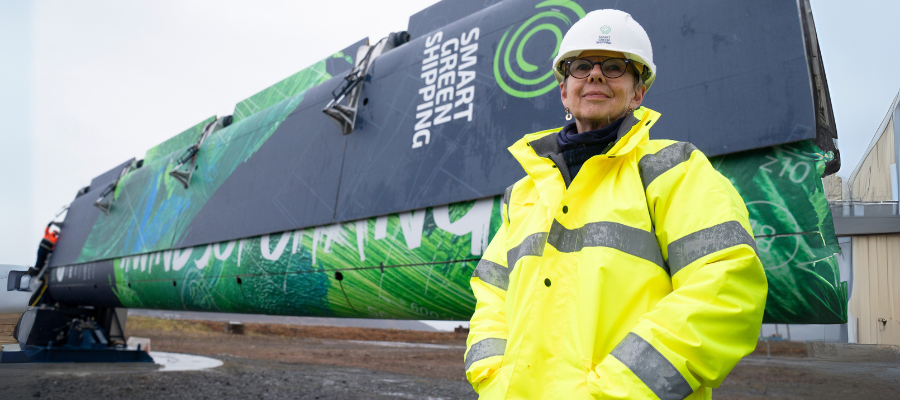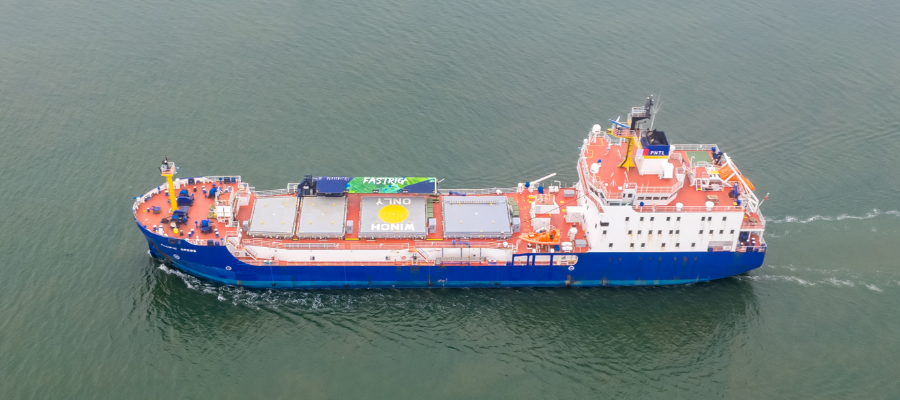🕒 Article read time: 5 minutes
Diane Gilpin, founder and CEO of Smart Green Shipping

Maritime innovator takes The Green Miles' nine question challenge.
Enabling the move away from fossil-powered ships is Diane Gilpin's Smart Green Shipping (SGS), an innovative company helping modern vessels harness the power of the wind using 21st century, digitally-enabled technology.
The FastRig from SGS is a Scottish solution that can help the shipping industry’s greenhouse gas reductions.
"Why didn't I think of that?" You may well ask. After all, it is a simple premise - huge 20-metre wings that propel cargo ships and reduce carbon emissions. When bolted to a vessel’s decks and sitting upright, the wing, called FastRig, will act as a sail harnessing the power of wind.
Gilpin said she started thinking about using wind on ships back in 1998, after a career at Formula One and in yacht racing. But can she handle our nine question dcearbonisation challenge?
- What are the biggest common sustainability challenges facing the whole logistics sector in your opinion?
Clean air, emissions reduction, reducing congestion.
The twin crises of climate change and the nature emergency mean that we are endangering the habitability of our home planet. We’re already seeing the consequences of climate change – extreme storms, floods, fires – and need to swiftly find ways to switch to cleaner more efficient solutions.
If we tackle the entire global logistics chain as a whole and shift as much freight as we can from land and air to water we immediately transition to the lowest cost and lowest emission transport mode.
Simultaneously we make waterborne transport cleaner through different propulsion solutions for different modes – batteries for inland waterways, wind-assist for deep sea for example – then we have an opportunity to make an immediate difference.

- And what are the hottest topics in decarbonisation of the logistics sector
Huge and significant segments of the maritime transport sector transitioning to alternative power solutions; retrofitting wind-assist for deep sea bulk/liquid transport; batteries for inland waterways and short-sea shipping.
Waterborne transport is, like all other sectors, complex and interconnected but it has multiple advantages – ships can move large quantities at anyone time reducing emissions per unit of freight ton mile; deep shipping has the unique advantage of being able to use wind for direct thrust (after all that’s how global trade began). By deploying wind-assist ships reduce fuel cost and dependency making their supply service more resilient.
Inland waterways, short sea shipping are less suited to wind but batteries can be used to power these close to population modes making air cleaner, reducing road congestion and yet still taking freight close to its final destination.
- Do you think the UK’s net zero goals are realistic?
I think they lack ambition. The option of not reducing emissions in line with science means everything else we worry about is academic – there are few large scale business options on a frozen/flooded/burning planet – now is not the time for pragmatism but ambition. Look what the EU is doing with an integrated transport strategy and an Maritime Industrial Strategy.
Europe recognises that developing their waterborne infrastructure will build resilience in an increasingly unstable world. The Europeans are asking: What ships do we excel at building? Can that knowledge, skill and expertise be transferred to other waterborne segments? What can we learn from other sectors – renewables, digital? Can we develop our economy whilst improving our security? I don’t hear any of these wide, interconnected conversations going on in the UK.
As a developer of technology for global shipping when we engage with government we’re neither fish nor fowl – not energy, not transport (because not much of global shipping’s total of 3% of the world’s emissions happen in UK waters so it’s ‘not our problem’) not manufacturing.
We have a huge opportunity for the UK to create jobs, wealth and a cleaner, more efficient environment but no one in UK government owns the problem. In Europe they’ve seen the opportunity and grasped it.

- What are the specific challenges faced by the different modal sectors?
I can only really speak to the maritime space but lack of availability of alternative fuels – which will be in demand by all sectors – can only push prices one way. Everyone has to look for ways of reducing fuel and power needs to improve efficiency.
Maritime has a number of power options, suitable for different ship types on different routes – batteries, shore power, biofuels - all of which are complex and expensive to install and operate.
Being an international sector makes life even more complicated – The ‘low hanging fruit’ for reduction of power demand - wind-assist; reducing friction through hull coatings; route optimisation – all of which can be done today and save cost.
Our plug&play autonomous, intelligent, retractable wingsails, FastRigs, have been specifically designed with shipping industry experts – ship owners, cargo owners, ports, financiers, insurers – to pragmatically address all of the issues, both real and perceived, to retrofitting 21st century wings onto existing maritime infrastructure so we reduce fuel use, and so costs; reduce emissions with no loss of service.
FastRigs are digitally enabled to optimise their performance when deployed and to allow frictionless, easy access to ship owners.
- What are the best examples of positive breakthroughs you have seen in the last decade?
Wind-assist in global shipping has the potential to reduce global emissions by 1% of total GHG – that means another 99 projects as impactful, and we’re done.
Exponential growth is being experienced by wind-assisted solutions. Wind-assisted Propulsion Solutions (WAPS) works alongside existing engines and any alternative- fuelled future systems; it can reduce emissions by at least 20% on some routes without any loss of service.
Using science-backed prediction tools, it builds certainty into operational models – certainty of energy supply is critical in an increasingly uncertain world where critical supply chains are at risk.

- Who is an inspirational figure in logistics decarbonisation?
I am inspired by Jaap Gebraad, Secretary General of Waterborne Transport Platform. He has brought together all the waterborne logistics segments in the EU – inland, short sea, ferries, deep sea, cruise and offshore support – to speak with one voice and to advocate for the increased use of waterborne transport to shift transport off roads to improve cost-effectiveness as well as sustainability.
There is a huge growth potential in pioneering new sustainable solutions and putting the UK and EU at the forefront of the inevitable sustainability shift. Just because current rhetoric and hostility to global trade is top of our minds right now, it won’t always be so. Jaap is able to look past the current ‘noise’ and see opportunities.
- With the growing emphasis on sustainability, do you see rail freight competing with road and air transport?
In a sane world, air transport would be minimised for everything other than critical (medical/military) supplies. Road transport would be minimised and electrified. Rail transport, integrated with waterborne modes – inland, short and deep sea shipping managed by smart digital systems - is the most cost-effective and sustainable way to go.

- How do logistics companies deal with ‘first mover hesitancy’?
There needs to be more courage, more pioneering spirit. There is a lot of it about in the waterborne sector. It may seem safer to wait to be a fast-follower but if no one leads we have a much harder time managing the inevitable transition and there will be more losses and failures as a result. Work collaboratively, build coalitions, share first mover risks.
- What does 2025 look like for logistics decarbonisation?
We hope for swift and easy transition – it could be! - but expect it will be messy and inefficient because that’s how humans tend to work.
.
Published On: 03/03/2025 12:46:33
